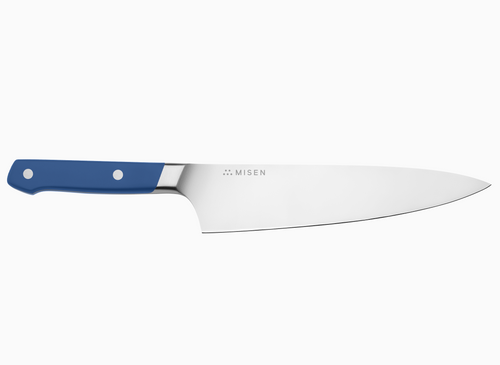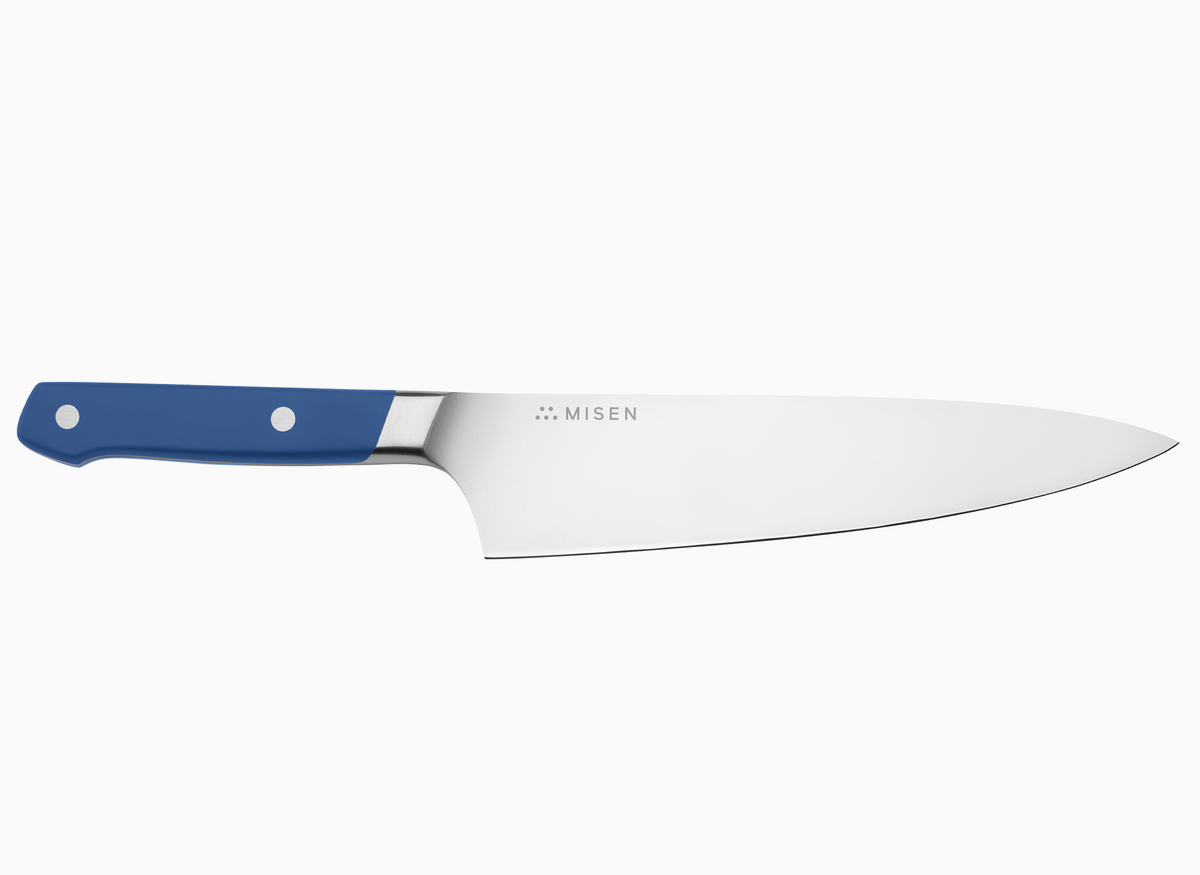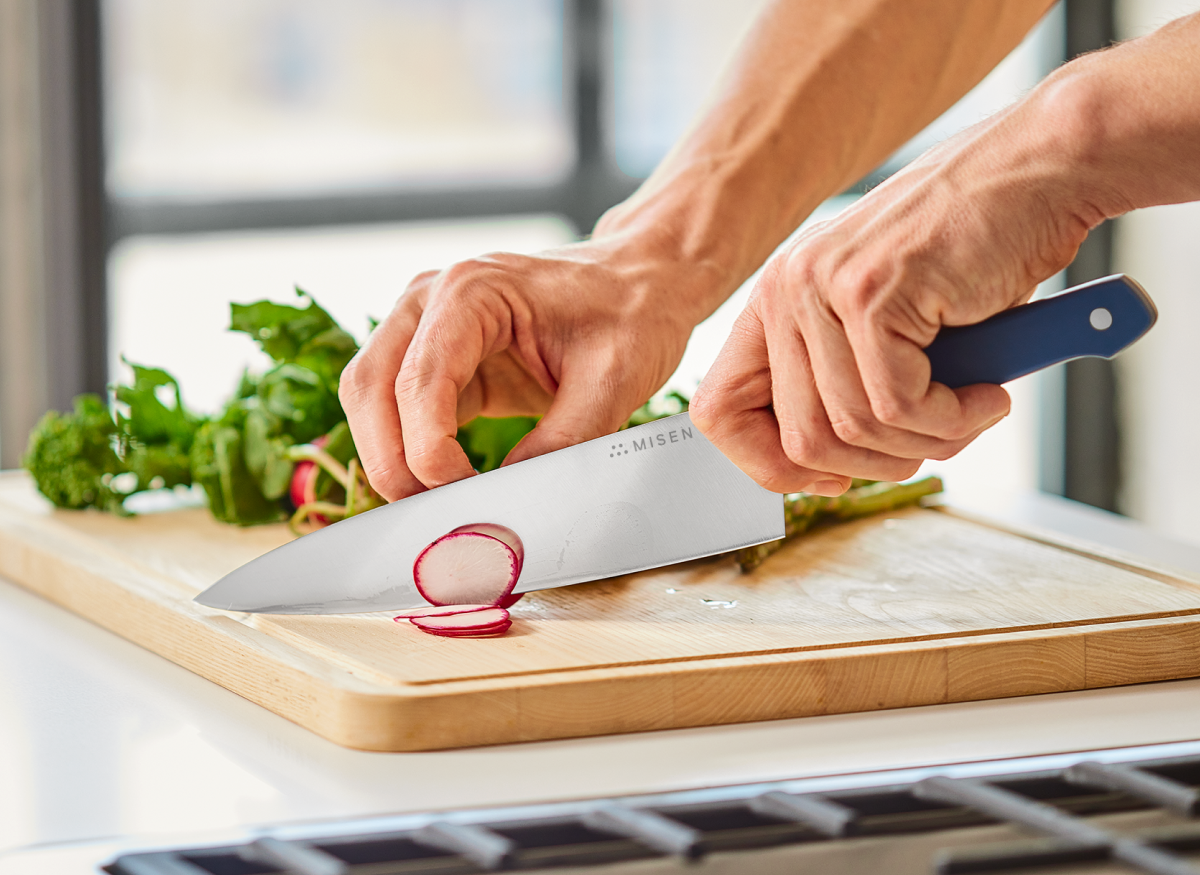The Benefits of Buying a Professional Chef’s Knife
 The shape of a chef's knife makes chopping more efficient.
The shape of a chef's knife makes chopping more efficient.
- A sharp blade makes a chef’s knife easier to use and control.
- The material your chef’s knife is made of will affect its performance.
- Carbon is the key metal alloy used in quality cutlery.
The right tool for a task makes it easier and creates better results. It’s why professional chefs and home cooks alike reach for their professional-quality chef’s knife for most of their prep work in the kitchen.
Unlike a paring knife or even a bread knife, chef’s knives are designed to be multi-purpose kitchen tools. While many things in the kitchen are designed for a specific task, chef’s knives (also called a cook's knives) can chop vegetables, slice fruit, mince fine herbs, cut up meat, and more. They range in length, but 8 inches is the most popular choice for the home cook.
The tip of a classic chef’s knife has a rounded taper. It helps with the rocking action that makes chopping and slicing more efficient. By keeping that front tapered part of the knife in contact with the chopping board, you can rock the knife and make quick work of mincing an onion.
These knives are comfortable to use, and when properly maintained, have a razor-sharp blade that reduces the effort it takes to cut and chop. Knives that aren’t sharp require more force to use. They slow you down. The blade also crushes more of the food’s delicate cells surrounding the cut.
You Don’t Have to Be a Professional
 If your knife is sharp enough, it will easily cut through an onion.
If your knife is sharp enough, it will easily cut through an onion.You don’t have to be a trained professional chef to use a chef’s knife. The “professional” part often thrown in front of the knife’s description refers to its craftsmanship. A chef’s knife worth buying was manufactured with the professional in mind. Home cooks use them to achieve professional results and to benefit from the versatility and efficiency that a well-crafted knife can offer.
A sharp blade gives you a high degree of control when you’re working with your chef’s knife. Chopping and cutting is more predictable, so there’s less risk of accidents. A professional chef’s knife is manufactured to be sharper and to maintain its sharpness longer.
Benefits of a Chef’s Knife
The extra sharpness of a well-maintained chef’s knife can help keep you healthier. Dull knives may be robbing you of nutrients.
Take a look at your cutting board after chopping vegetables or herbs. Notice any smudges on the surface of the cutting board? It’s a sign that your knife is crushing more than cutting. A sharp knife slices cleanly through herbs, vegetables, and fruits, so you’ll keep more of what’s good for you in the food you slice.
Less effort in preparation means you’ll have more time to enjoy cooking. And if you happen to like chopping, slicing, and dicing, you’ll appreciate it even more when you do it with a chef’s knife that’s been professionally manufactured for the job.
There’s also the benefit of pride in ownership. A quality chef’s knife is thoughtfully designed to help you be a better cook through proper preparation.
Staying Sharp
 A stainless steel blade is easy to care for but won't stay sharp as long.
A stainless steel blade is easy to care for but won't stay sharp as long.
A professional chef’s knife stays sharp, and it’s the type of steel used to forge the blade that keeps it that way.
Some chef’s knives feature ceramic blades. According to science, this might be a good choice to make the best knife. Material hardness determines how long a blade stays sharp, and other than diamonds, nothing is harder than ceramic.
Unfortunately, this theory doesn’t hold up in practical use. Ceramic chef’s knives start out sharp and may retain their sharpness longer than knives with steel blades, but ceramic blades are also prone to chipping and cannot be sharpened by a home cook.
It’s why the world’s top knife manufacturers — from Germany’s Zwilling J.A. Henckels to Japan’s Shun — use steel.
Not All Steel is Created Equal
There’s a wide variety of alloy combinations for steel knives. The ingredients or alloys added to the steel determine the blade’s characteristic. Like the ingredients in a food recipe, changing the added alloy or the amount of alloy added will change the steel blade’s performance.
Stainless Steel
One alloy combination produces stainless steel, which is the most popular type of steel for a chef’s knife because it’s resistant to rust, easy to clean, and won’t affect the flavor of food.
Chromium is what makes steel stainless. It also results in slightly softer steel, so your stainless steel chef’s knife may need to be sharpened more frequently. Stainless steel also contains cobalt, manganese, nickel, molybdenum, tungsten, and vanadium, which contribute strength, hardness and resistance to wear. Many of the most popular German and French knife makers prefer stainless steel blades.
High-Carbon Steel
Not all chef knife blades are made of stainless steel. Some are made from carbon steel, which means they don’t contain alloys like chromium. Carbon steel is much harder than stainless steel, and because of that, it’s possible to snap the tip off a knife made from carbon steel. Carbon steel knives can also discolor when used on fruits or vegetables with a high acid content, such as tomatoes or citrus. And it can rust if not properly cared for.
The benefit of carbon steel is that it stays sharper because the alloys used make the blade harder. This choice might appeal to you if you want to sharpen your chef’s knife less often and you’re not put off by the idea of a stained or discolored blade (or a little extra care to avoid that). Many of the most popular Japanese chef’s knife manufacturers feature carbon steel blades.
Damascus Steel
Some of the best chef’s knives are made with Damascus steel, which means that the knife-maker melts both stainless steel and carbon steel together and then repeatedly forges the metal. The process produces beautiful wavy patterns in the steel. It also creates a blade that can stay sharper longer than carbon steel if properly honed.
Choosing Your Steel
With any of these types of steel, carbon is the key alloy that determines the quality of the chef’s knife blade. It’s what gives iron strength. Chef’s knife manufacturers that place a focus on sharp edge retention and durability use more carbon. Misen, for example, uses premium Japanese stainless steel with a carbon content that’s 60% higher than other knife makers.
Sharp Is Good, but What Else Is Important?
More than just metal determines the cutting characteristics of a professional chef’s knife. The cutting edge angle can make a difference in the blade’s sharpness. The more acute the angle of the knife blade, the sharper the edge. And different kinds of manufacturers make knives with different edge angles.
Japanese-Style Knives
Japanese knife manufacturers generally create a blade angle of 7-8 degrees on both sides of the blade, which leads to a 14-16 degree bevel. This narrow cutting angle slices easily through meat and fish without damaging the protein’s cellular structure. It also preserves texture and flavor. The harder alloys preferred by some knife-makers allow the steel knife edge to maintain this bevel.
The Japanese also have their own style of knife, similar to the chef's knife, called the santoku knife. It has a shorter blade length than the standard 8-inch chef's knife and features a sheepsfoot blade shape that’s thinner than a chef's knife.
A santoku knife may only have a bevel on one side of its blade. It's become such a popular knife that non-Japanese knife manufacturers, such as Switzerland's Victorinox Fibrox, now make them.
German-Style Knives
German knife makers prefer to add just a couple more degrees to each side of the bevel. They tend to create a 10-degree angle on each side for an overall 20-degree bevel. The actual edge or apex of the blade is still sufficiently sharp. It’s just a bit beefier and can take more abuse — perhaps in the form of powering through a frozen pork chop or an acorn squash.
German knives like the Wüsthof Classic are crafted heavier than their Japanese counterparts so the weight of the knife can help to cut through the ingredients, unlike Japanese knives, which instead rely on the extra sharpness that they get from their narrower cutting angle.
What to Pair With Your Chef’s Knife
 Hone your knife at least once a week for the best performance.
Hone your knife at least once a week for the best performance.
Get the best performance out of your pro chef’s knife by using and maintaining it as recommended by the manufacturer. You’ll need to hone and sharpen it. You’ll also want to make sure you have a proper surface to cut on.
Honing Rods
Many kitchen knives are sold as sets. Knife sets comes with a rod, which has fine grooves that run parallel to its length. If you didn’t get a honing rod with your knife set, you can also buy them separately to add to your kitchen essentials.
Honing rods are used to straighten the microscopic teeth that line the edge of the blade. Honing your knife helps to maintain its sharpness.
Sharpeners
Even the harder steel and more acute angle of a Japanese-style chef’s knife will need occasional sharpening. Sharpen it with a whetstone. The process is more involved than using an electric or manual knife sharpener, but most professional chefs say it’s the best approach. It removes the least amount of material of all the sharpening methods. Home cooks also say it can be a therapeutic and relaxing exercise.
Cutting Boards
There’s a big difference of opinion on which kind of surface is the best for cutting. To protect you knives, look for either plastic or wood cutting boards.
Plastic seems is sturdy but not hard enough to affect the edge of your knife when you chop or cut. Plus, it’s tough enough to throw in the dishwasher after you’ve cut up some raw chicken. But keep in mind that even the high heat of the dishwasher may not be sufficient to remove bacteria.
Wood is a better choice. It harbors less bacteria than plastic. Spend the extra money and find an end grain wood cutting board. The orientation of the closed grain hardwood prevents it from warping because of moisture, and there’s little possibility of splintering or chipping.
Prep Like a Pro
You don’t have to be a certified chef to use a knife that bears the title. No one’s going to ask to see your certificate from Le Cordon Bleu or the Culinary Institute of America. A good chef’s knife is professionally manufactured to help cooks of any skill level increase their confidence in the kitchen.








